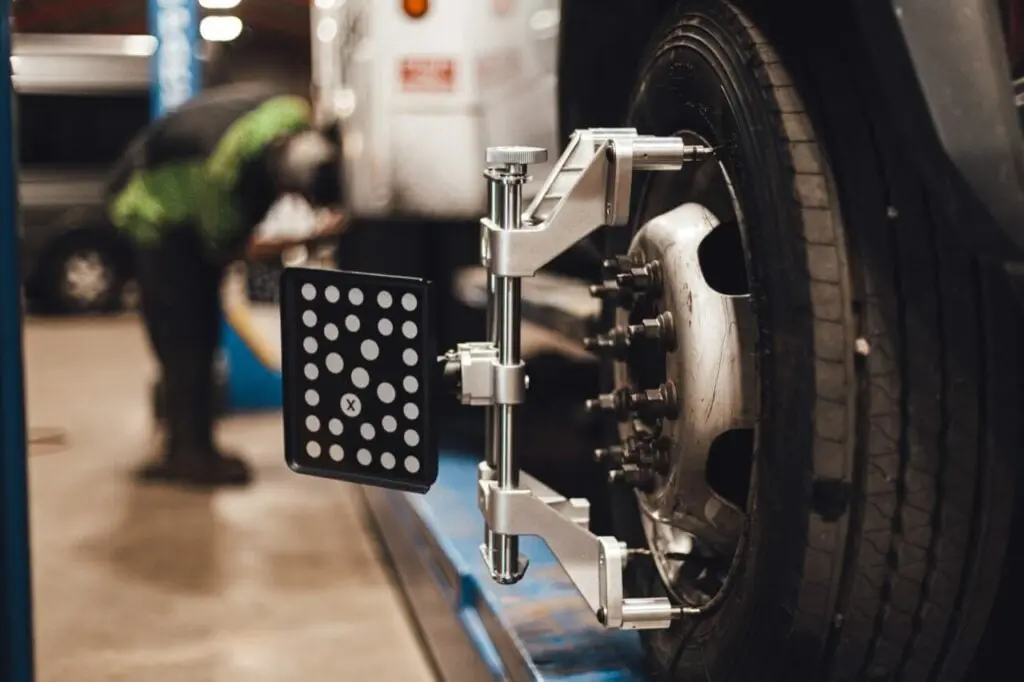
When driving long distances, it’s very common to notice that your vehicle drifts to the left or right. This occurs when you do not align your wheels correctly. It may mean you need truck alignment services soon.
Just like regular cars, heavy-duty trucks use suspensions. Your wheel hubs connect to the steering knuckle with either ball joints or kingpins. These are parts that let your wheels move up, down, or sideways based on how you drive your truck. However, they can wear out over time and lead to wheel alignment issues.
Driving long distances on bad suspensions can wear them out. They may no longer stay level with the truck body. This can lead to serious problems, such as damaging your wheels when they contact potholes or rocks.
You will know you need a wheel alignment when your truck pulls to one side when you press the gas. This makes you steer left or right to drive straight down the road.
What is the Solution for Truck Wheel Alignment?
The first thing you’ll need to do is have your suspension checked to see if the problem is actually with your alignment. This means you should have a DOT inspection done on all your ball joints and kingpins. Additionally, ensure that your tie rods are firmly attached at both ends.
Realign Your Truck Wheels
The most typical remedy for alignment issues is to have your wheels realigned. This involves having all four corners of your vehicle re-measured, allowing the technician to make necessary adjustments. While this can help resolve any drifting problems you may experience, it does not address any underlying issues within your suspension system.
If faulty wheel alignment causes serious damage, you might need to replace your wheel bearing or steering knuckle. You should also examine the ball joints and kingpins to make sure they aren’t damaged. If your wheels are alloy, the mechanic may need to weld them or replace them if they can’t be fixed.
If your wheel is bent, you will need to replace it. This will help the truck wheels return to their correct position.
Preventative Maintenance
Regular and preventative maintenance is key to ensuring your vehicle remains in good condition. After addressing any alignment issues, it’s important to keep an eye on your tires. Check for uneven wear, which can indicate alignment problems or issues with your suspension. Rotating your tires every 5,000 to 7,500 miles can help promote even wear and extend their lifespan.
Additionally, consider having your suspension system inspected periodically. A well-functioning suspension not only improves ride quality but also enhances handling and safety. If you notice any unusual noises, such as clunking or squeaking, it may be a sign that components like shocks or struts need attention.
Don’t forget about the importance of regular brake checks as well. Worn brake pads or discs can affect your vehicle’s performance and safety. If you feel vibrations or hear grinding when braking, it’s time to have them inspected.
In summary, maintaining your vehicle’s alignment, suspension, and brakes is crucial for safe driving. By staying proactive with these checks and repairs, you can ensure a smoother ride and potentially save on costly repairs down the road. Always consult with a qualified mechanic if you’re unsure about any issues, as they can provide expert advice tailored to your specific vehicle needs.
Frequently Asked Questions
Proper wheel alignment is crucial for three key reasons: safety, cost-efficiency, and driver comfort. A correctly aligned truck is safer to operate, as it handles more predictably and reduces driver fatigue on long hauls. It also saves you money by preventing premature and uneven tire wear, which is one of the largest maintenance expenses for any fleet. Finally, a proper alignment improves fuel economy by minimizing rolling resistance, ensuring your truck operates as efficiently as possible.
For optimal performance and tire life, we recommend having your truck’s alignment checked at least once a year or every 80,000 to 100,000 miles as part of your preventative maintenance schedule. However, you should have it checked immediately after installing new tires, replacing steering or suspension components, or after any significant impact with a curb or road hazard. More frequent checks may be necessary if your truck operates on poorly maintained roads.
The most common sign is uneven or rapid tire wear, particularly on the edges of the front tires. You may also notice that your truck naturally pulls or drifts to one side when you are trying to drive straight, or that the steering wheel is not centered even when the truck is moving forward. A vibrating steering wheel can also be an indicator that your wheels are out of alignment.
The primary cause of misalignment is the general wear and tear on steering and suspension components that occurs during normal operation. Every bump and turn contributes to gradual changes in the alignment angles. Significant impacts, such as hitting a deep pothole, running over debris on the road, or striking a curb, can knock your wheels out of alignment instantly. Worn-out parts like tie rods, ball joints, and bushings can also prevent the vehicle from holding a proper alignment.
Schedule Semi Truck Service at Inland Kenworth
To schedule service, fill out the form below or find the nearest location to you and get in touch.
